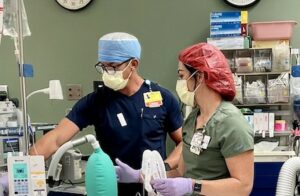
Scot Brown, CRNA, is well known by his patients and the community in Socorro, New Mexico. “Everyone knows me as the ranch kid who does anesthesia at the hospital,” he said.

Brown has been a Certified Registered Nurse Anesthetist (CRNA) since 2016 and has lived in Socorro — a town of 8,414 an hour outside of Albuquerque — since he was four years old. He grew up on the ranch where he still raises cattle. He works two weeks on-call 24/7 at Socorro General Hospital, then two weeks at the ranch. He’s a fourth-generation rancher and was also the first in his family to go to college.
“There were quite a few of us ranch kids who went on to college, but I was the only one who returned to the community,” he said. “One big thing that affects the rural community is when they have talent, that talent doesn’t come home. But I knew I wanted to come back to Socorro.”
After studying nursing in college, he began his career as a flight nurse — a registered nurse trained to provide medical care for patients as they’re transported via helicopter or small aircraft. Although he’d never considered going on to a career as a nurse anesthetist when he was in nursing school, he remembers the moment he decided to become a CRNA.
“I was intubating a 19-year-old motorcyclist who had gotten hit by a drunk driver. We were in the middle of the road, and I thought I’d rather save lives in a more controlled setting,” he said.
In addition to his work as a flight nurse, Brown also worked in the ICU and the emergency room at a hospital prior to attending an anesthesia program. All CRNAs are required to have a minimum of one year of full-time experience as a registered nurse in a critical care setting before beginning their education in nurse anesthesiology. Brown had 13 years of critical care experience before he became a CRNA.
“Because of those 13 years of experience before anesthesia school, I’m the critical care person and the anesthesia person here in Socorro,” he said.

Brown said his education and training prepared him for the challenges that come with being on-call 24/7 as a solo provider. At Socorro General Hospital, he functions as a critical care intensivist and provides anesthesia for all types of surgical procedures and for non-surgical procedures like colonoscopies and endoscopies, as well as epidurals for labor and delivery.
Across the United States, CRNAs are the sole anesthesia providers in the vast majority of rural hospitals. CRNAs enable these hospitals to offer surgical, obstetrical, trauma stabilization, and pain management services.
“Our critical care experience prior to going to anesthesia school is what makes CRNAs such strong providers,” he said. “We know how to manage a person who’s having a heart attack or septic shock or any number of health issues, because we saw those patients in the ICU.”
Brown’s critical care experience makes a measurable impact in his small rural community, where the nearest ICU is over an hour away. People can stay in their community to receive healthcare, and if they need to be transferred to a larger facility, a CRNA is there to ensure their safety.
“This little hospital here wouldn’t be able to provide services or hold on to ICU patients awaiting transfer if it weren’t for independently practicing CRNAs with strong critical care skills,” Brown said.